We all know our market vegetables and fruits are trusted edible species, but what about wild plants? Here are a few common (North American) goodies that are safe to eat if you find yourself stuck in the wild. First of all, please note that you need to know with absolute certainty the identity of what you are finding and collecting as survival food. If you are not sure – leave it alone.
#1. Blackberries
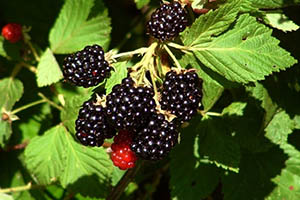 Many wild berries are not safe to eat, so it’s best to stay away from them. But wild blackberries are 100% safe to eat and easy to recognize. They have red branches that have long thorns, similar to a rose, and the green leaves are wide and jagged.
Many wild berries are not safe to eat, so it’s best to stay away from them. But wild blackberries are 100% safe to eat and easy to recognize. They have red branches that have long thorns, similar to a rose, and the green leaves are wide and jagged.
They are best to find in the spring, when their white flowers bloom; they are clustered all around the bush and their flowers have 5 points. The berries ripen around August to September. Avoid berries grown in what could be post-industrial / polluted soil, as well as those close to roads. They have essentially been fumigated with engine fumes all year round.
Related: If You See This Berry, You May Want To Harvest It
#2. Dandelions
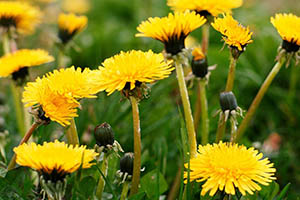 Dandelion is the easiest to recognize; in the spring they show their bright yellow buds. You can eat the entire thing raw, or cook them to take away the bitterness. Usually in the spring, they are less bitter.
Dandelion is the easiest to recognize; in the spring they show their bright yellow buds. You can eat the entire thing raw, or cook them to take away the bitterness. Usually in the spring, they are less bitter.
They are packed with Vitamin A and Vitamin C, and beta-carotene.
#3. Asparagus
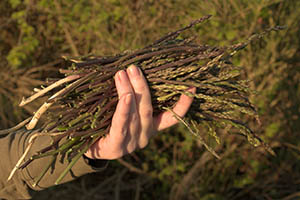 The vegetable that makes your pee smell funny grows in the wild in most of Europe and parts of North Africa, West Asia, and North America.
The vegetable that makes your pee smell funny grows in the wild in most of Europe and parts of North Africa, West Asia, and North America.
Wild asparagus has a much thinner stalk than the grocery-store variety. It’s a great source of source of vitamin C, thiamine, potassium and vitamin B6. Eat it raw or boil it, like you would your store bought asparagus.
#4. Elderberries
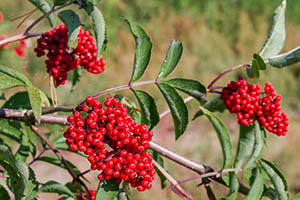 An elderberry shrub can easily grow about 10 feet and yield tons of food. Their leaf structure is usually 7 main leaves on a long stretched out stem; the leaves are long and round and have jagged edges.
An elderberry shrub can easily grow about 10 feet and yield tons of food. Their leaf structure is usually 7 main leaves on a long stretched out stem; the leaves are long and round and have jagged edges.
These are easiest to identify in the spring, as they blossom white clustered flowers that resemble an umbrella. Mark the spot and harvest the berries when they’re ripe around September.
Elderberries are known for their colds and flu healing properties. They very sweet and delicious, so you can also make jelly from them.
#5. Gooseberries
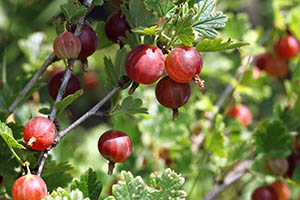 These are also common in the woods, in northern Missouri. The branches are grey and have long red thorns, and the leaves are bright green and have 5 points. They have rounded edges and look similar to the shape of a maple leaf.
These are also common in the woods, in northern Missouri. The branches are grey and have long red thorns, and the leaves are bright green and have 5 points. They have rounded edges and look similar to the shape of a maple leaf.
The flowers are very odd looking in the spring; they are bright red and hang down. the berries ripen around late May- early June.
#6. Mulberries
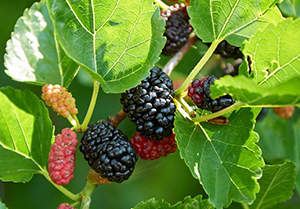 Mulberry leaves have two types, one spade shape, and a 5 fingered leaf. Both have pointed edges.
Mulberry leaves have two types, one spade shape, and a 5 fingered leaf. Both have pointed edges.
You can eat mulberries both raw and cooked. They are most often used to make pies, pastries, and jellies. They also make a very nice sweet fruit wine.
The leaves, fruit, and bark all have medicinal value. Use the fruit and leaves during the summer months when they are readily available and switch to bark tea during the winter when the trees are bare.
#7. Pine
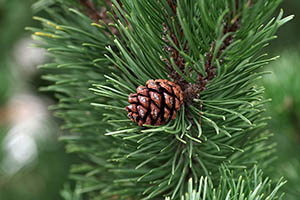 There are over a hundred different species of pine. It can be used not only as food, but also for medicinal purposes.
There are over a hundred different species of pine. It can be used not only as food, but also for medicinal purposes.
Simmer a bowl of water and add some pine needles to make tea. Native Americans used to ground up pine to cure scurvy, due to it being rich in vitamin C.
Related: How Our Forefathers Made Glue Out of Pine Resin
#8. Kudzu
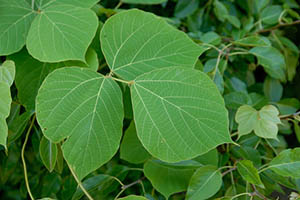 Pretty much the entire plant is edible, and is also known for medicinal values. The leaves can be eaten raw, steamed or boiled. The root can be eaten as well.
Pretty much the entire plant is edible, and is also known for medicinal values. The leaves can be eaten raw, steamed or boiled. The root can be eaten as well.
Warning: pregnant and breastfeeding women should consult a physician before use.
#9. Daylily
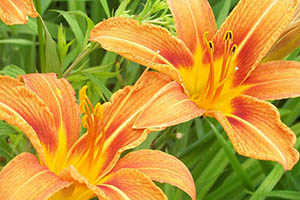 You can find this plant in many parts of the country. This plant is different from Tigerlily or Easterlily, which are toxic.
You can find this plant in many parts of the country. This plant is different from Tigerlily or Easterlily, which are toxic.
Daylily is completely safe to eat. It has bright orange flowers that come straight out of the ground; their main stock/stem has no leaves, and this is your confirmation that it’s a daylily. You can eat them whole or cook them or put them in salads.
#10. Pecans
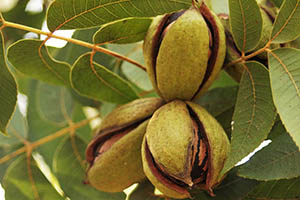
The trees usually mature around 20-30 ft, but some can grow up to 100 ft tall.
The leaves are bright green and long, and have smooth edges. The pecans themselves grow inside green pods, and when ripe the pods open and the seeds fall to the ground.
#11. Hazelnuts
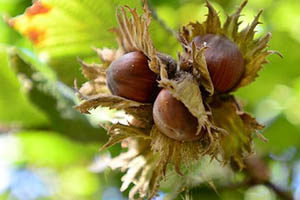 Hazelnut trees are short and tend to be around 12-20 ft tall.
Hazelnut trees are short and tend to be around 12-20 ft tall.
The leaves of the Hazelnut tree are bright green and have pointed edges. The hazelnuts themselves grow in long strands of pods, and they usually ripen by September and October.
Related: 79 Edible Flowers in North America (with Pictures)
#12. Walnuts
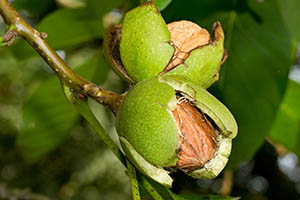 Walnut trees are one of the most easy to recognize trees, and the tallest nut tree in North America. They can range from 30 to 130 feet tall.
Walnut trees are one of the most easy to recognize trees, and the tallest nut tree in North America. They can range from 30 to 130 feet tall.
The leaf structure is very similar to the pecan: the leaves are spear like and grow on a long stem, with 6-8 leaves on both sides.
The leaves’ edges are smooth and green, and the walnuts tend to grow in clusters and ripen in the fall.
#13. Acorns
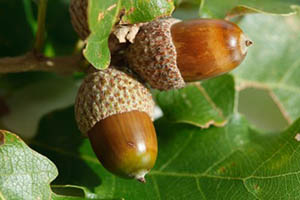 Acorn trees are another tree species that is highly recognizable as well.
Acorn trees are another tree species that is highly recognizable as well.
Acorns tend to be a bit bitter.
People should only eat a small amount of acorns, and make sure they cook them properly beforehand.
#14. Hickory Nuts
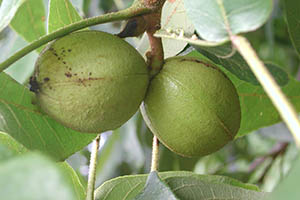 Hickory nut trees can grow about 50 to 60 feet tall.
Hickory nut trees can grow about 50 to 60 feet tall.
Their green leaves are spear like and have pointed edges. They can grow very large.
The hickory nuts are round and tend to ripen in September or October.
#15. Cattail
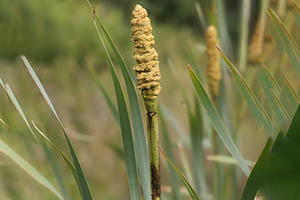 Known as cattails or punks in North America, and bullrush and reedmace in England, the Typha Genus is usually found near the edges of freshwater wetlands.
Known as cattails or punks in North America, and bullrush and reedmace in England, the Typha Genus is usually found near the edges of freshwater wetlands.
Cattails were a staple in the diet of many Native American tribes. Most of a cattail is edible. You can boil or eat raw the root stock or rhizomes, of the plant. The root stock is usually found underground. Make sure to wash off all the mud.
The best part of the stem is near the bottom, where the plant is mainly white. Either boil or eat the stem raw. Boil the leaves like you would spinach.
#16. Garlic Mustard
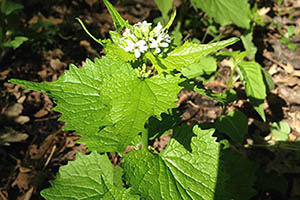 Edible parts: flowers, leaves, roots, and seeds.
Edible parts: flowers, leaves, roots, and seeds.
Leaves can be eaten in any season, but when the weather gets hot, the leaves will have a taste bitter.
Flowers can be chopped and tossed into salads. The roots can be collected in early spring and again in late fall, when no flower stalks are present. Garlic mustard roots taste very spicy somewhat like horseradish. In the fall the seed can be collected and eaten.
#17. Chickweed
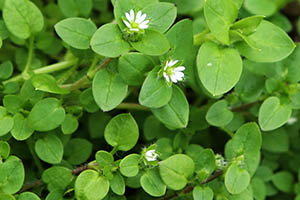 These usually appear in May and July.
These usually appear in May and July.
You can eat the leaves either raw or boiled, as they’re high in vitamins and minerals!
Warning: pregnant and breastfeeding women should consult a physician first before use.
#18. Herb Robert
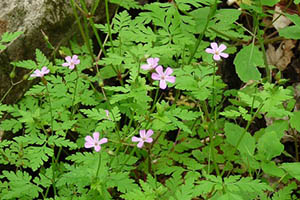 The entire plant is edible. Fresh leaves can be used in salads, or for tea. The flower, leaves, and root can be dried and stored for later use, either as a tea or as herbs (nutrient booster).
The entire plant is edible. Fresh leaves can be used in salads, or for tea. The flower, leaves, and root can be dried and stored for later use, either as a tea or as herbs (nutrient booster).
Rubbing fresh leaves on the skin is known to repel mosquitoes, and the entire plant repels rabbits and deer, which would complement and protect your garden.
#19. Beach Lovage
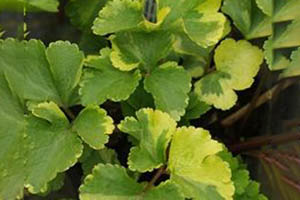 Use the leaves raw in salads or salsas, or cooked in soups, with rice, or in mixed cooked greens.
Use the leaves raw in salads or salsas, or cooked in soups, with rice, or in mixed cooked greens.
Beach lovage can have a strong flavor and is best used as a seasoning, like parsley, rather than eaten on its own.
This plant tastes best before its flowers appear, and is also called Scotch lovage, sea lovage, wild celery, and petrushki.
#20. Plantain
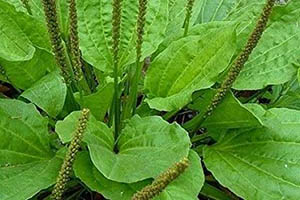 Plantain is one of those plants that seems to thrive right on the edge of gardens and driveways, and it’s also edible.
Plantain is one of those plants that seems to thrive right on the edge of gardens and driveways, and it’s also edible.
Pick the green, rippled leaves and leave the tall flower stems. Blanch the leaves and sauté them with some butter and garlic, just as you would with kale or any other tough green.
Related: This Common Driveway Weed is One of Nature’s Most Powerful Survival Plants
#21. Garlic Grass
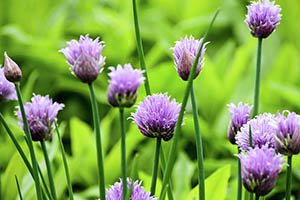 Garlic grass (Allium vineale or wild garlic) is an herbal treat often found lurking in fields, pastures, forests and disturbed soil.
Garlic grass (Allium vineale or wild garlic) is an herbal treat often found lurking in fields, pastures, forests and disturbed soil.
It resembles cultivated garlic or spring onions, but the shoots are often very thin. Use it in sandwiches, salads, pesto or chopped on main courses like scallions.
#22. Watercress
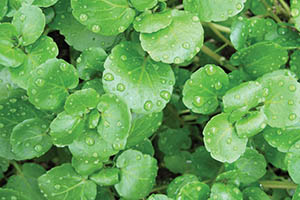
Watercress is an aquatic plant in the Brassicaceae (Mustard) Family. It is related to mustard and horseradish.
The peppery leaves and seeds are edible and are used mainly as a condiment or a garnish in salads. Leaves are also used for arthritis, as a diuretic, a purgative, an expectorant, and have stimulant properties.
#23. Lamb’s Quarter
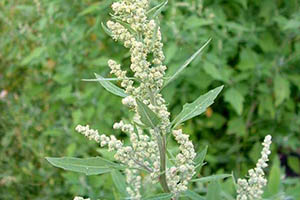 Lamb’s Quarters is also called Pigweed, Fat Hen, and Goosefoot. Use the leaves raw in salads, or cooked in soups, in mixed cooked greens, or in any dish that calls for cooking greens.
Lamb’s Quarters is also called Pigweed, Fat Hen, and Goosefoot. Use the leaves raw in salads, or cooked in soups, in mixed cooked greens, or in any dish that calls for cooking greens.
Lamb’s Quarters are susceptible to leaf miners; be careful to harvest plants that are not infested. Although Lamb’s Quarters are best before the flowers appear, if the fresh young tips are continuously harvested, Lamb’s quarters can be eaten all summer.
#24. Goose Tongue
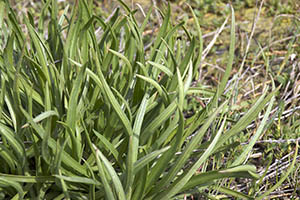 Use the young leaves raw in salads, or cooked in soups, in mixed cooked greens, or in any dish that calls for cooking greens.
Use the young leaves raw in salads, or cooked in soups, in mixed cooked greens, or in any dish that calls for cooking greens.
Goosetongue is best in spring and early summer, before the flowers appear. It can be confused with poisonous Arrowgrass, so careful identification is essential.
Related: The 5 Most Common Edible Weeds In Your State
#25. Pigweed
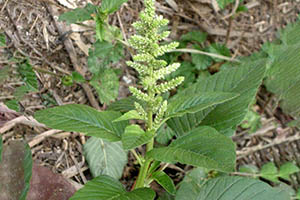 Edible parts: The whole plant – leaves, roots, stem, seeds. The Amaranth seed is small and very nutritious and easy to harvest, the seed grain is used to make flour for baking uses.
Edible parts: The whole plant – leaves, roots, stem, seeds. The Amaranth seed is small and very nutritious and easy to harvest, the seed grain is used to make flour for baking uses.
Roasting the seeds can enhance the flavor, also you can sprout the raw seeds using them in salads, and in sandwiches, etc. Young leaves can be eaten raw or cooked like spinach, sautéed, etc. Fresh or dried pigweed leaves can be used to make tea.
#26. Monkey Flower
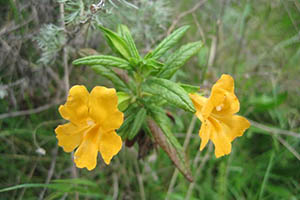 Monkey Flower is best before the flowers appear, although the flowers are also edible and are good in salads or as a garnish.
Monkey Flower is best before the flowers appear, although the flowers are also edible and are good in salads or as a garnish.
Use the leaves raw in salads, or cooked in soups, mixed cooked greens, or any dish that calls for cooking greens.
#27. “Self-Heal” Prunella vulgaris
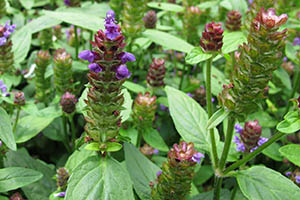 The young leaves and stems can be eaten raw in salads; the whole plant can be boiled and eaten as a potherb, and the aerial parts of the plant can be powdered and brewed in a cold infusion to make a tasty beverage.
The young leaves and stems can be eaten raw in salads; the whole plant can be boiled and eaten as a potherb, and the aerial parts of the plant can be powdered and brewed in a cold infusion to make a tasty beverage.
The plant contains vitamins A, C, and K, as well as flavonoids and rutin. Medicinally, the whole plant is poulticed onto wounds to promote healing. A mouthwash made from an infusion of the whole plant can be used to treat sore throats, thrush and gum infections. Internally, a tea can be used to treat diarrhea and internal bleeding.
#28. Mallow
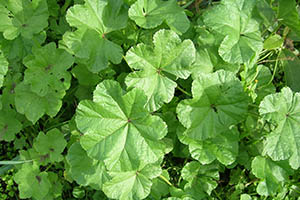 All parts of the mallow plant are edible — the leaves, the stems, the flowers, the seeds, and the roots. Because it’s a weed that grows plentifully in neglected areas, mallows have been used throughout history as a survival food during times of crop failure or war.
All parts of the mallow plant are edible — the leaves, the stems, the flowers, the seeds, and the roots. Because it’s a weed that grows plentifully in neglected areas, mallows have been used throughout history as a survival food during times of crop failure or war.
Mallows are high in mucilage, a sticky substance that gives them a slightly slimy texture, similar to okra, great in soups. Mallow has a nice pleasant nutty flavor. One of the most popular uses of mallows is as a salad green.
Related: How To Identify And Prepare Nutritious Mallows
#29. Miner’s Lettuce
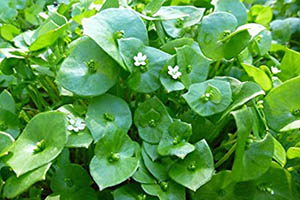 The flowers, leaves and root are all edible. Leaves can be eaten raw or cooked. The young leaves are best, older leaves can turn bitter especially, in the summer and if the plant is growing in a hot dry position. Although individual leaves are fairly small, they are produced in abundance and are easily picked.
The flowers, leaves and root are all edible. Leaves can be eaten raw or cooked. The young leaves are best, older leaves can turn bitter especially, in the summer and if the plant is growing in a hot dry position. Although individual leaves are fairly small, they are produced in abundance and are easily picked.
Stalks and flowers can be eaten raw, making a nice addition to the salad bowl. The bulb can also be eaten raw. Although very small and labor-intensive to harvest, the boiled and peeled root has the flavor of chestnuts.
#30. Sweet Rocket (Hesperis matronalis)
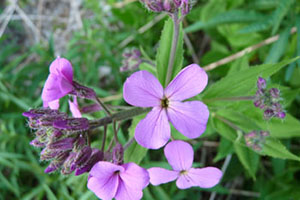 This plant is often mistaken for Phlox. Phlox has five petals, Dame’s Rocket has just four. The flowers, which resemble phlox’, are deep lavender and sometimes pink to white. The plant is part of the mustard family, which also includes radishes, broccoli, cabbage, cauliflower, and, mustard.
This plant is often mistaken for Phlox. Phlox has five petals, Dame’s Rocket has just four. The flowers, which resemble phlox’, are deep lavender and sometimes pink to white. The plant is part of the mustard family, which also includes radishes, broccoli, cabbage, cauliflower, and, mustard.
The plant and flowers are edible but fairly bitter. The flowers are attractive added to green salads. The young leaves can also be added to your salad greens (for culinary purposes, the leaves should be picked before the plant flowers). The seed can also be sprouted and added to salads.
NOTE: It is not the same variety as the herb commonly called Rocket, which is used as a green in salads.
#31. Wild Bee Balm
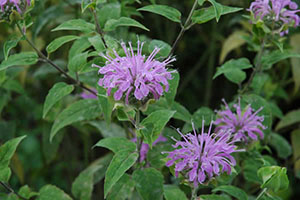 Leaves are boiled for tea, used for seasoning, chewed raw or dried. They taste like the main ingredient in Earl Gray Tea and can be used as a substitute. Flowers are edible too and have a minty flavor.
Leaves are boiled for tea, used for seasoning, chewed raw or dried. They taste like the main ingredient in Earl Gray Tea and can be used as a substitute. Flowers are edible too and have a minty flavor.
Wild bee balm tastes like oregano and mint. The taste of bee balm is reminiscent of citrus, with soft mingling of lemon and orange. Any place you use oregano, you can use bee balm blossoms. The leaves and flower petals can also be used in both fruit and regular salads.
#32. Marshmallow
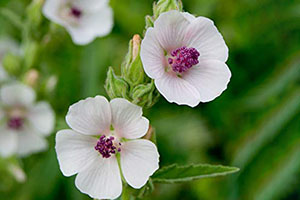 The common marshmallow plant is grown commercially for medicinal use, but it can be found in many places in the US growing wild. The plant grows in cool, moist places such as the grassy banks of lakes and streams and on the edges of marshes.
The common marshmallow plant is grown commercially for medicinal use, but it can be found in many places in the US growing wild. The plant grows in cool, moist places such as the grassy banks of lakes and streams and on the edges of marshes.
The leaves, flowers, root, and seeds are all edible. The roots contain a mucilage, which is sweet in flavor.
#33. Pineapple Weed
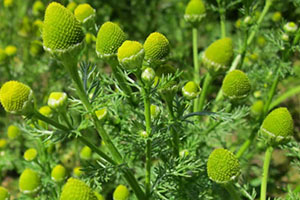 Pineapple weed flowers and leaves are a tasty finger food while hiking, or toss in salads. Flowers can also be dried out and crushed so that it can be used as flour.
Pineapple weed flowers and leaves are a tasty finger food while hiking, or toss in salads. Flowers can also be dried out and crushed so that it can be used as flour.
As with chamomile, pineapple weed is very good as a tea. Native Americans used a leaf infusion (medicine prepared by steeping flower or leaves in a liquid without boiling) for stomach gas pains and as a laxative.
#34. Milk Thistle
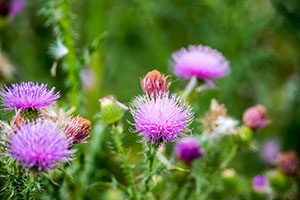 Milk thistle is most commonly sought for its medicinal properties of preventing and repairing liver damage. But most parts of the plants are also edible and tasty. Until recently, it was commonly cultivated in European vegetable gardens.
Milk thistle is most commonly sought for its medicinal properties of preventing and repairing liver damage. But most parts of the plants are also edible and tasty. Until recently, it was commonly cultivated in European vegetable gardens.
Leaves can be de-spined for use as salad greens or sautéed like collard greens; water-soaked stems can be prepared like asparagus; roots boiled or baked; flower pods used like artichoke heads.
#35. Prickly Pear Cactus
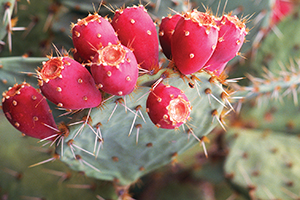 Found in the deserts of North America, the prickly pear cactus is a very tasty and nutritional plant that can help you survive the next time you’re stranded in the desert.
Found in the deserts of North America, the prickly pear cactus is a very tasty and nutritional plant that can help you survive the next time you’re stranded in the desert.
The fruit of the prickly pear cactus looks like a red or purplish pear. Hence the name. Before eating the plant, carefully remove the small spines on the outer skin or else it will feel like you’re swallowing a porcupine. You can also eat the young stem of the prickly pear cactus. It’s best to boil the stems before eating.
#36. Mullein (Verbascum thapsus)
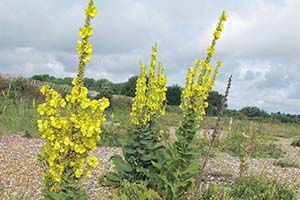 Edible parts: Leaves and flowers. The flowers are fragrant and taste sweet, the leaves are not fragrant and taste slightly bitter.
Edible parts: Leaves and flowers. The flowers are fragrant and taste sweet, the leaves are not fragrant and taste slightly bitter.
This plant is best known for a good cup of tea and can be consumed as a regular beverage. Containing vitamins B2, B5, B12, and D, choline, hesperidin, para amino benzoic acid, magnesium, and sulfur, mullein tea is primarily valued as an effective treatment for coughs and lung disorders.
#37. Wild Grape Vine
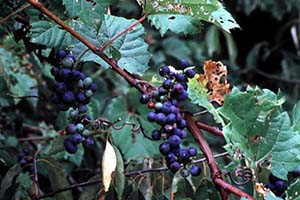 Edible parts: Grapes and leaves. The ripe grape can be eaten but tastes better after the first frost. Juicing the grapes or making wine is most common.
Edible parts: Grapes and leaves. The ripe grape can be eaten but tastes better after the first frost. Juicing the grapes or making wine is most common.
The leaves are also edible. A nutritional Mediterranean dish called “dolmades”, made from grape leaves are stuffed with rice, meat, and spices. The leaves can be blanched and frozen for use throughout the winter months.
#38. Yellow Rocket
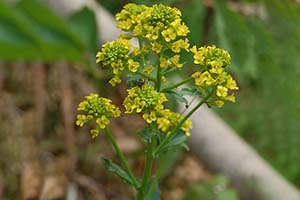 Yellow Rocket was initially cultivated in England as an early salad vegetable. It tends to grow in damp places such as hedges, stream banks and waysides, and comes into flower from May to August.
Yellow Rocket was initially cultivated in England as an early salad vegetable. It tends to grow in damp places such as hedges, stream banks and waysides, and comes into flower from May to August.
It makes a wonderful salad green when young, and the greens are also an excellent vegetable if treated kindly. Lightly steam or gently sweat in butter until just wilted. The unopened inflorescences can also be picked and steamed like broccoli.
#39. Purslane
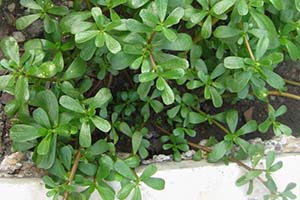 While considered an obnoxious weed in the United States, purslane can provide much-needed vitamins and minerals in a wilderness survival situation. Gandhi actually numbered purslane among his favorite foods.
While considered an obnoxious weed in the United States, purslane can provide much-needed vitamins and minerals in a wilderness survival situation. Gandhi actually numbered purslane among his favorite foods.
It’s a small plant with smooth fat leaves that have a refreshingly sour taste. Purslane grows from the beginning of summer to the start of fall. You can eat purslane raw or boiled. If you’d like to remove the sour taste, boil the leaves before eating.
Related: If You See This Weed Growing In Your Yard, Don’t Pick It – Here’s Why
#40. Wild Black Cherry
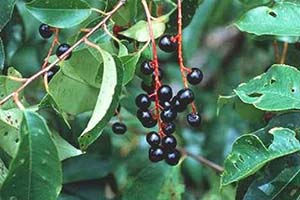 Wild black cherries are edible, but you shouldn’t eat a lot of them raw; only use the cherries that are still on the branches and are deep black in color, not red.
Wild black cherries are edible, but you shouldn’t eat a lot of them raw; only use the cherries that are still on the branches and are deep black in color, not red.
If you see cherries on the ground leave them alone; when cherries wilt they contain a lot of cyanide. It’s only best eaten when cooked, it negates or destroys the cyanide.
#41. Sheep Sorrel
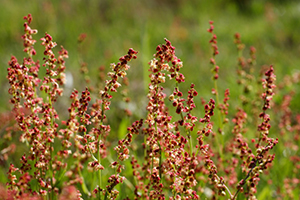 Sheep sorrel is native to Europe and Asia, but has been naturalized in North America. It’s a common weed in fields, grasslands, and woodlands. It flourishes in highly acidic soil. Sheep sorrel has a tall, reddish stem and can reach heights of 18 inches.
Sheep sorrel is native to Europe and Asia, but has been naturalized in North America. It’s a common weed in fields, grasslands, and woodlands. It flourishes in highly acidic soil. Sheep sorrel has a tall, reddish stem and can reach heights of 18 inches.
It contains oxalates and shouldn’t be eaten in large quantities. You can eat the leaves raw. They have a nice tart, almost lemony flavor.
#42. Wild Mustard
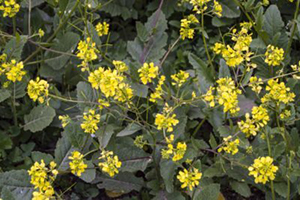 Wild mustard is found in the wild in many parts of the world.
Wild mustard is found in the wild in many parts of the world.
It blooms between February and March. You can eat all parts of the plant: seeds, flowers, and leaves. I like to eat the young leaves in salads, and I sometimes cook the older leaves as a vegetable or potherb. The seeds make a spicy condiment or flavoring when finely ground.
#43. Wood Sorrel
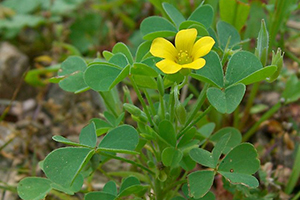 You’ll find wood sorrel in all parts of the world; species diversity is particularly rich in South America. The flowers can range from white to bright yellow and its greenery are clovers.
You’ll find wood sorrel in all parts of the world; species diversity is particularly rich in South America. The flowers can range from white to bright yellow and its greenery are clovers.
Humans have used wood sorrel for food and medicine for millennia. The Kiowa Indians chewed on wood sorrel to alleviate thirst, and the Cherokee ate the plant to cure mouth sores. The leaves are a great source of vitamin C., and the roots can be boiled. They’re starchy and taste a bit like a potato.
#44. Fiddleheads
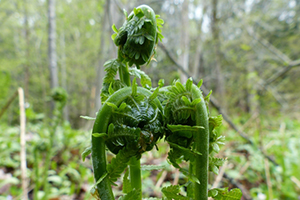 The term “fiddleheads” refers to the unfurling young sprouts of ferns. Although many species of ferns are edible as fiddleheads, Ostrich Ferns are the best.
The term “fiddleheads” refers to the unfurling young sprouts of ferns. Although many species of ferns are edible as fiddleheads, Ostrich Ferns are the best.
They are edible only in their early growth phase first thing in the spring.
#45. Wild Blueberries
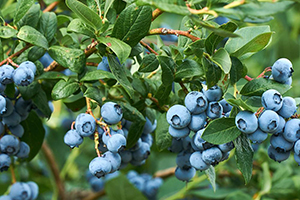 Wild Blueberry fields and barrens contain many different varieties of berries, which accounts for the variations in size and color that characterize the Wild Blueberry crop. Blueberries are familiar to most people in Canada and the USA.
Wild Blueberry fields and barrens contain many different varieties of berries, which accounts for the variations in size and color that characterize the Wild Blueberry crop. Blueberries are familiar to most people in Canada and the USA.
They do grow wild in many places, and the blueberries are delicious when ripe. The flowers are said to be edible as well.
#46. Jerusalem Artichoke
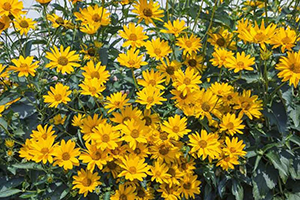 Also called sunroot, sunchoke, and earth apple, the Jerusalem artichoke is a species of sunflower found in Eastern North America.
Also called sunroot, sunchoke, and earth apple, the Jerusalem artichoke is a species of sunflower found in Eastern North America.
Jerusalem Artichokes have small tubers on the roots that are delicious. They can be eaten raw, made into flour, pickled, or cooked. For some people, Jerusalem artichokes cause flatulence and gastric pain, so watch for gastric problems when Jerusalem artichokes are first introduced to the diet.
Related: 10 Vegetables That You Can Stockpile Without Refrigeration For A Full Year
#47. Mayapple
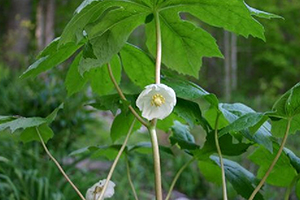 Mayapple has large deeply cut leaves, a single large white flower under the leaves, and one single yellow fruit. It is one of the first plants to come up in the spring. They are found in the forest, and their fruit is covered by their large leaves. The ripe fruits are edible.
Mayapple has large deeply cut leaves, a single large white flower under the leaves, and one single yellow fruit. It is one of the first plants to come up in the spring. They are found in the forest, and their fruit is covered by their large leaves. The ripe fruits are edible.
WARNING: Do not eat the fruit until it is ripe. Ripe fruits are yellow and soft. Unripe fruits are greenish and not soft. They are slightly poisonous when unripe: green fruits are strongly cathartic.
#48. Trout Lily
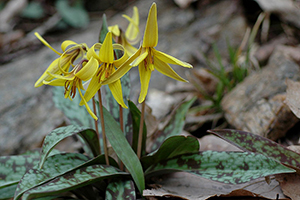 Also known as Dogtooth Violet and Adder’s Tongue, these bright yellow flowers are one of the first to bloom in the spring.
Also known as Dogtooth Violet and Adder’s Tongue, these bright yellow flowers are one of the first to bloom in the spring.
They have small pointy leaves, are found in the forests, and are edible raw.
#49. Wild Leeks
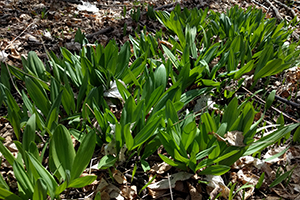 Wild Leeks are onion-like plants that grow in the deep woods. They come up in the spring, usually before much of anything else has come up.
Wild Leeks are onion-like plants that grow in the deep woods. They come up in the spring, usually before much of anything else has come up.
The leaves and bulbs are edible. Please only collect when abundant, and then only collect scattered patches or individual plants. Ill effects may be experienced by some people if large amounts are eaten. If they don’t smell like onions, they aren’t Wild Leeks.
#50. Black Locust Flowers
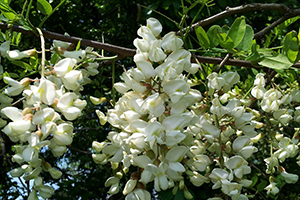 Black Locust is native to the Appalachian Mountain area and is considered an invasive tree in other places. It grows quickly, and often in clusters, crowding out native vegetation and aggressively invading fields.
Black Locust is native to the Appalachian Mountain area and is considered an invasive tree in other places. It grows quickly, and often in clusters, crowding out native vegetation and aggressively invading fields.
The roots alter the nitrogen content of the soil. Most parts of the tree are toxic, causing digestive system problems. It is only the flowers that we can gather and consume.
#51. Violets
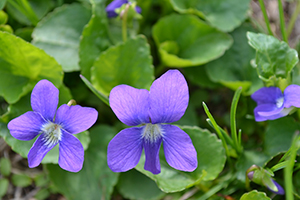 Along the fringes of my lawn in the shady areas are violets, several varieties. This is an incredible edible. The leaves are high in vitamin C and A.
Along the fringes of my lawn in the shady areas are violets, several varieties. This is an incredible edible. The leaves are high in vitamin C and A.
I use both the leaves and flowers in salads. Keep in mind that late-season plants without flowers may be confused with inedible greens. Play it safe. Forage this plant only when it is in bloom.
#52. Wild Onions
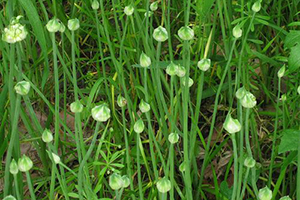 Wild onions and wild chives grow in fields or disturbed land. Relocate chives to your yard. It will come up faithfully year after year.
Wild onions and wild chives grow in fields or disturbed land. Relocate chives to your yard. It will come up faithfully year after year.
The whole plant may be chopped into salads, soups, chili, and stews. Likewise for wild garlic, if you are lucky enough to find this elusive plant. There is some evidence that eating wild onions, wild garlic or wild chives may reduce blood pressure and lower blood sugar.
You may also like:
 How to Make Dandelion Bread (With Pictures)
How to Make Dandelion Bread (With Pictures)
An Insanely Effective Way to Build a 5 Year Food Stockpile (Video)
12 Wild Medicinal Plants You Should Harvest This Fall
Similar to Morphine: The Best Natural Painkiller that Grows in Your Backyard

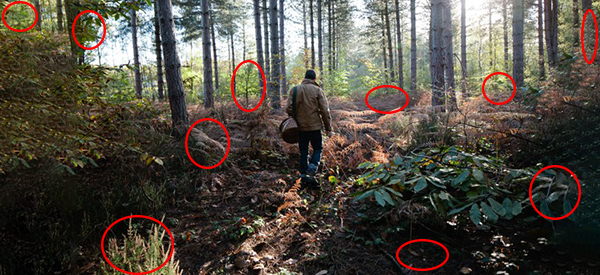













You need an accurate picture of a mulberry. They do NOT grow on shrubs. They grow on trees and the leaves are exceptionally large.
Thank you so much, Dr D. I updated it.
In the original picture it was a Boysenberry plant
I have a Pakistani, and they’re more of a large shrub. But, American and Asian can get very tall. Female trees have heart-shaped serrated leaves. BTW, I’m looking for native mulberry trees, but so far, no one local carries them. niio
Excellent app! Thank You ♉️???????♾❤️??
loved the edible plant email, Im familiar with some of what you mentioned, however most are more indigenous to temperate climate areas.
Any chance, you could do a list of edibles commonly found in the south, esp Florida? there must be somethings other than bull rushes. Thank you in advance.
eat the weeds has lots of foraging plants from the south
The Elderberries in the picture don’t look anything like mine. Never have I seen a red Elderberry. I have them all over my property and the berries are dark blue to deep purple, depending on how long they have been on. When they first ripen they are covered with a yeast mold that gives them a powdery blue color. You can make a sourdough starter with them or toss a handful in your pancake batter like Blueberries. Champagne can be made with the flowers. These Elderberries get to 20 feet tall. You can eat a few raw but they should be cooked before consuming a large amount to neutralize *I forget what* that can make you very sick.
Red elderberries are from Europe. Yours are native and agronomists call them blueberry elder. niio
I’ve never seen red elderberries either. The ones where I live (in Cornwall, United Kingdom) are dark, almost black.
My mistake. Reds are a West Coast plant. Donno why I was thinking Europe, sorry. Was getting tired, I guess.http://www.eattheweeds.com/elderberries-red-white-and-blue/ niio
the red ones from washington have been said to be poisonous probably need to cook it we tell kids dont eat it
I like this, tho most will never grow here. We get 13-16 inches of weather a year. 16 is considered a wet year. But, what we have is spectacular this year. Some of the honey mesquite put on a second crop. that’s a high-energy feed stock for humans and people. Even coyotes eat as much as they can. It’s about 24% natural sugar so can you blame them? Javalina tracks are all over out in the brush, the pigs knocking down ripe prickly pears to eat, thorns and all. Yes, this is another Arizona gentle woodland critter, at least till they pass all those thorns. Desert hackberries are ripe now and tasty. Blue oaks and Engleman’s grow on the mountains, and the acorns are tannin-free, but roast them or something else will eat them. Tepary beans came up, but only a few. Rabbits and deer take them as fast as they can, and ants will carry off the tiny beans. Deeper in the valley, ironwood trees produce small seeds. Yucca fruit (datil) and roots, and banana yucca (fruit and roots), and leaf fibers make good, strong twine. Pines, maples trees (big tooth and Rocky Mtn) are good for a mushroom patch and to tap, if you can find any big enough. Black walnuts, wild pecans, feral olive brush, wild palms, American and foreign. niio!
I couldn’t find native mulberry in Texas so I kept my eyes open for a seedling, dug it up and transplanted it out by my garden. Now I have mulberry trees coming up everywhere! A big ol mulberry is heaven on earth for migrating birds.
You must have Pinyon in the mountains, do the little Mexican Persimmons grow in the washes in Arizona?
Yucca flowers are good Tempura style, 3 parts rice flower, one part cornstarch, enough cold beer to make a medium thin batter, deep fry to a light golden brown. Day lilly flowers, in the article, are said to make excellent tempura.
I’m eating pecans right now, what’s everybody eating that didn’t come from the store?
Yeah, but not here. The San Pedro River is usually dry from year to year, then acts like it has diarrhea. Blooms, buds, and roots on day lilies are good. Cattle and sheep like the leaves. I make rice dough, fermenting uncooked rice for a few weeks. Makes a good sourdough for Asian cooking. I got my pecans off a neighbor, who has 7 trees. Her kid got 3 bucks for 5 pounds (what he was selling them for). I got a Pakistani mulberry. They stand up to the wind and heat. But, I’d like a native one and can’t find them. They used to be common. Tomorrow, char siu pork and the day after, Gen. Tso’s eggplant (same sauce, sourdough rice breading, deep-fry). It’s the best thing ever to happen to eggplant 🙂 niio
They do NOT look like my elderberries either. Mine do have a very brief red phase as they transform from green to a deep purple almost black but I have never observed a uniform red as in the picture and mine have large nearly flat blossum and fruit heads some six or more inches in diameter. Make a very tasty jelly and some people use the juice sometimes diluted in a little water to treat cold symptoms.
I cut the entire blossum/berry head from the stalk, then in the kitchen use scissors to trim out the larger stalks as they will induce a slightly bitter flavor, add a little water and bring to a boil and simmer for ten minutes or so then mash well with a potato masher an either drip out with a jelly bag or as I prefer run thru a Foley food mill to remove seeds and skins. this will press thru the fruit pulp and make more of a jam where dripping will give more of a clear jelly, I like the jam better and it gives a much higer yield frm the same amount of berries. Great on toast or muffins orPBJ, or on pancakes or heated and drizzled over spongecake.
Juice also makes good wine if you are so inclined.
It is said that one can make wine from elderberries too. Here on the left coast we have red elderberries. The wild medicinal plants guru said that elderberry seeds have cyanide in them but in such small quantity that eating a few seeds will cause no harm. He recommended against consuming large quantities of them. Apparently many fruits’ seeds contain cyanide in small quantities.
Samuel Thayer’s books are my favorite (most complete identification at different stages of growth, wide ranging, most detailed as to safe preparation) resource I’ve found for actually using wild foods effectively. If anyone plans to eat wild edible plants in an emergency it is a good idea learn how to prepare them before your life depends on it. You never know – perhaps you will find some local cuisine to enjoy on a regular basis. I did!
You just reminded me, I have to get wild onion seeds, and for eatable lilies, as well. Ajo Lily is good for hidden gardens. People have them in flower beds and don’t know they’re good to eat. (and i ain’t tellin’; them 🙂 JL Hudson is a good source for the southwest. Thanks! niio
Dig up wild onions and transplant them, they like a fairly wet site, and let them reproduce as bulbs for a few years. I have wild technicolor dreams if I eat a lot of wild onion in a meal.
Ferment uncooked rice, do the grains break down? Use in dumplings? Sounds good.
If you haven’t read this yet, do so. It’s awesome. https://www.askaprepper.com/how-i-survived-alone-for-10-months-living-off-the-land/
In a wet year, we get 16″ of weather. That includes blizzards,which might drop 2 inches or more of snow. Scary, huh “) So far since January, we got mebbe 11.5 inches.
Ajo Lily and other bulbs are types of onion and garlic, but native. They like it hot, dry, and plenty of caliche (aka desert concrete/natural baking soda) and generally look pretty nice in a hidden garden.
Asian noodle dough: I use a damp towel and a lid to cover the bucket. Raw rice, wash two or three times, let drain well. It can be partially cooks, but tends to break up when fermenting. I put it in a food-grade bucket (nothing metal) and cover with water. A little yeast or some sourdough works to start it. It can take 3 weeks, and needs to be watched and skimmed on occasion. Keep covered with water. Some people let it go up to 6 months. Er..:) When it’s fermenting well, The water is redneck Japanese rice beer. If you want to make rice wine, use wine yeast. When it’s done fermenting, strain the rice. The water is rice wine vinegar. When the rice is strained, put it in a food processor or wet grinder and pulverize. I don’t refrigerate the vinegar, and the dough should be sour enough to keep on a shelf for a few weeks. I had some in the fridge that was there for a month and no mold. When making dumplings or noodles, cheat, add about 1/3 corn starch to the dough. Nothing else is needed but a pot of boiling water or a steamer. Great taste. With the starch, you can make stuffed pancakes. Make pancake batter of it, put in pan, add stuffing (chili, char sui, what you like), cover with more batter and bake till done. manga, good eating, niio
You really have to know how to identify your plants. If you eat the wrong ones you might get very sick, or kill yourself.
red elderberries are poisionous. blue elderberries are edible
Plantain seeds can be dried and later sprouted for salads.
You have the photos of hickory nut and walnut reversed